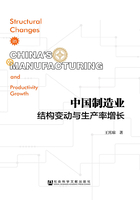
Abstract
Structure change is the salient feature of modern economic growth. Productivity growth brought about by structural change is the key to promoting economic development. Since the 1980s, the rapid development of China's manufacturing industry has become the engine of“Chinese economic miracle”. The development of the manufacturing industry is not only reflected in the rapid increase of output, but also reflected in structural adjustment. In the year of 2008, the outbreak of the global financial crisis has fully demonstrated the importance of real economy. The manufacturing industry is the core of the real economy. Therefore, in the process of industrialization, the manufacturing industry is the basis for future sustainable development of China's economy. After entering the new century, the cost of labor and land is increasing, the constraints of resource and environment are further intensified, the increase in the productivity of the manufacturing industry is the main path of development. In this context, to study the influence on sectoral productivity brought about by the structure change in the manufacturing industry is of practical significance to the development of the manufacturing industry and the transformation of the mode of economic growth in the future.
Based on the theory of development economics, neoclassical growth theory and evolutionary economics, this article analyzes the economic mechanism through which, the structure change affect sectoral productivity. Based on the current situation and trend of structural change in China's manufacturing industry after the reform and opening up, this article identifies those significant factors which affect the structure change of China's manufacturing industry. And using stochastic frontier production function, dynamic panels and other methods, we measure the role of structure change of China's manufacturing industry in sector productivity growth, and study the contribution of the marketalization and technological progress in this process.
Based on the above study, we draw the following conclusions.① There were significant change in the structure of China's manufacturing industry after the reform and opening up. Given the availability of data, we measure the role of structure change of China's manufacturing industry in sector productivity growth between 1986 and 2011. During this period, this influence demonstrated a downward trend over time. The contribution of structural change in the manufacturing sector to total factor productivity reached the greatest point during the 1990s, especially in the first half of the nineties. After entering the new century, this contribution showed a downward trend, far below that of the nineties. ② The Contribution of market reforms in the productivity effects of structure change shows the one-time property. In the nineties when government rapidly advanced market-oriented reforms, this kind of contribution was relatively prominent. The contribution of market-oriented reforms is based on the gap between the efficient allocation of resources and invalid allocation. Once the implementation of reform measures eliminates this gap, these reform measures will lose the ability to change the structure and enhance the sectoral productivity growth. Also, Most of the contribution of market reforms comes from the correction of labor price distortions. After 2000, the contribution from correcting capital price distortions has been rising,but its share was still small. Although market reforms can only promote structural change and bring about the growth of sectoral productivity in the short term, in the long run, the degree of the development of market mechanisms determines the level of sophistication and rationalization of industrial structure. In the future, it is necessary to deepen market reforms. ③ The contribution of the technological progress to the productivity effect of structure change is embodied in two aspects. First, the rising proportion of the industry of technological progress leads to the increased productivity of the manufacturing sector. We can call this the direct contribution. Second, the industry of rapid technological advances through“the spillover associated with the users, ”etc. , promotes the productivity growth in other industries, and ultimately improves the sector productivity, which can be called the indirect contribution. Our study demonstrated the role of the technological progress rely more on indirect contribution. The reason for this result is that after the reform and opening up, the increase of labor in those industries with rapid technological progress is limited, that is to say, because the demand has not massive increase these industries did not absorb too much labor. ④ Combining these findings and taking into account the background of the new industrial revolution in the future, the measure that promote China's structure change of the manufacturing industry should concern to facilitate the integration of the traditional industries and the emerging industries, coordinate structure adjustment of manufacturing industry between regions of China, timely capture the opportunity of institution adjustment and transform selective industrial policy to functional industrial policy.
Keywords: Structure Change; Productivity Growth; China's Manufacturing Industry; Market Reforms; Technological Progress